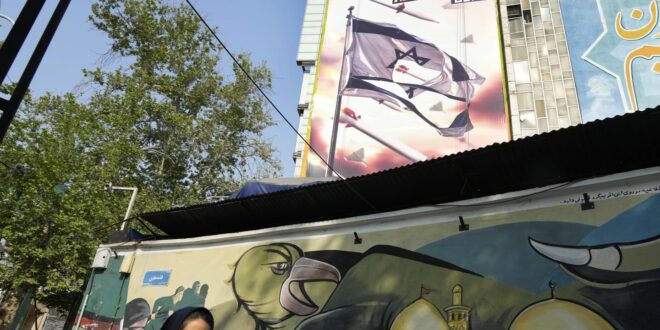Iran’s direct attack on Israel over the weekend upended decades of its shadowy warfare by proxy, something Tehran has used to manage international repercussions for its actions. But with both economic and political tensions at home boiling, the country’s Shiite theocracy chose a new path as changes loom for the Islamic Republic.
Supreme Leader Ayatollah Ali Khamenei will mark his 85th birthday Friday, with no clear successor in sight and still serving as the final arbiter of every decision Iran makes. Coming to power in the wake of Iran’s devastating eight-year war with Iraq in the 1980s, Khamenei preached for years about “strategic patience” in confronting his government’s main rivals, Israel and the United States, to avoid open combat.
That saw Iran invest more deeply in regional militia forces to harass Israel — such as Hamas in the Gaza Strip or Lebanon’s Hezbollah militia — and contain the U.S., like with the militias that planted devastating improvised explosives that killed American troops during the Iraq war. That’s extended even into impoverished Yemen, where Iran’s arming of the Houthi rebels empowered their takeover of the capital and checkmated a Saudi-led coalition still trapped in a yearslong war there.
That strategy changed Saturday. After days of warnings, Iran launched 170 bomb-carrying drones, more than 30 cruise missiles and more than 120 ballistic missiles toward Israel, according to an Israeli count. Those weapons included the same bomb-carrying drones Iran supplied to Russia for its grinding war on Ukraine.
Despite Israel and the U.S. describing 99% of those projectiles being shot down, Iran has called the attack a success. Iranian Foreign Minister Hossein Amirabdollahian said Monday the attack was “to deter, punish and warn the Zionist regime.” Khamenei himself had called for Iran to “punish” Israel as well.
The trigger for the attack came April 1, when a suspected Israeli strike hit a consular annex building by Iran’s Embassy in Damascus, Syria, killing at least 12, including a top commander of Iran’s paramilitary Revolutionary Guard’s expeditionary Quds Forces.
However, for years, Iran and Israel have been targeting each other’s interests across the Middle East.
Israel is suspected of assassinating Iranian nuclear scientists and sabotaging atomic sites in the Islamic Republic. In Syria, Israel has repeatedly bombed airports likely to interrupt Iranian weapons shipments, as well as killed other Guard officers. Meanwhile, Iran is suspected of carrying out a host of bombings and gun attacks targeting Jews and Israeli interests over the decades.
But the embassy attack struck a nerve with the Iranian government.
“Attacking our consulate is like attacking our soil,” Khamenei said April 10.
It also comes amid a moment filled with uncertainty for Iran. As Khamenei grows older, power has become ever-more consolidated in the country.
Hard-liners control every lever of power within both security services and political bodies, with none of the relative moderates who once shepherded Iran’s nuclear deal with world powers into existence.
That includes former President Hassan Rouhani, who led the effort. Authorities barred Rouhani earlier this year from running again to hold his seat on the Assembly of Experts, the 88-cleric body that will pick Iran’s next supreme leader.
The hard-liners’ grip on power has seen voter turnout drop to its lowest level since the 1979 Islamic Revolution. Their stranglehold also leaves them as the only political faction to blame as the public remains incensed by Iran’s collapsing economy.
The nuclear deal’s demise, after former President Donald Trump unilaterally withdrew America from the accord in 2018, has seen Iran’s rial currency tumble. The rial now seesaws near record lows, trading Monday at 658,000 to the dollar — down from 32,000 at the time the agreement was reached nearly a decade ago.
Already, prosecutors in Tehran have begun a criminal investigation into the Jahan-e Sanaat newspaper and a journalist over a story on the possible economic impact of Iran’s attack on Israel. The judiciary’s Mizan news agency described the report as “disturbing the psychological security of society and making the country’s economic atmosphere turbulent.”
His case comes as other journalists and activists report being summoned by authorities, portending a new crackdown on any sign of dissent in the country.
There are also signs that authorities appear to be preparing for a new push at enforcing the country’s mandatory headscarf, or hijab, laws for women.
“The Tehran police — as in all other provinces — will start to confront all lawbreaking with regard to the hijab,” said Tehran police chief Brig. Gen. Abbas Ali Mohammadian, according to the semiofficial ISNA news agency.
Some women in Tehran still walk through the streets with their hair uncovered, a continued protest since the nationwide 2022 demonstrations over the death of Mahsa Amini, arrested by police for not wearing a hijab to their liking. United Nations investigators say Iran was responsible for Amini’s death and violently put down largely peaceful protests in a monthslong security crackdown that killed more than 500 people and saw over 22,000 detained.
A new push for hijab enforcement may reignite that anger, particularly in Tehran. Meanwhile, rumors persist that the government may soon raise the country’s heavily subsidized gasoline prices. A price increase in 2019 grew into nationwide antigovernment protests that reportedly saw over 300 people killed and thousands arrested.
Those tensions, coupled with hard-liners’ grip on power and Khamenei’s age, signal more changes loom for the country. And while Iran said of its attack Saturday that “the matter can be deemed concluded” even before missiles reached Israel, that doesn’t mean there won’t be further retaliation from the country.
 Eurasia Press & News
Eurasia Press & News


